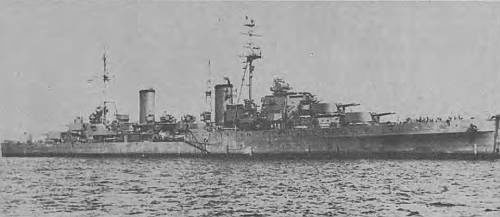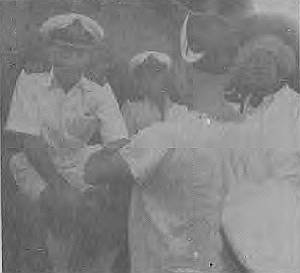- Author
- Scrivner, R.
- Subjects
- Biographies and personal histories
- Tags
-
- RAN Ships
- HMAS Yarra II, HMAS Sydney II, HMAS Sydney I, HMAS Penguin (Shore Base - Balmoral), HMAS Hobart II, HMAS Tasmania, HMAS Vampire I, HMAS Huon I, HMAS Canberra I, HMAS Brisbane I, HMAS Perth I, HMAS Hobart I, HMAS Protector I, HMAS Albatross
- Publication
- December 1974 edition of the Naval Historical Review (all rights reserved)

For practically three years from the outbreak of World War II, Harry Howden commanded HMAS Hobart, easing this ship through hers and also his own finest hours – hours, indeed days and months during which every man of her crew could only speak with unabashed personal praise. Certainly he was a hard taskmaster when he knew what he wanted, and what he wanted was one of his loves or particular interests. That ship just had to perform at her highest pitch, and every person had to do his utmost to oblige the skipper. Those who had served under Howden during crisis days knew for whom they were reacting and gladly performed. His Executive Officer for a long period was Commander Ken (‘Winnie’) Walton, RAN, and the two made a good team of leaders.
So strong was Captain Howden’s influence during those days of continued pressure from the enemy, be it German, Italian or Japanese, the image lasted through another three (although one, then Commander Fred Cook, DSC, RAN, was Acting Captain) wartime Captains seemingly as though they had to pay respect and show loyalty to the crew. A good crew had been moulded because of her Captain and because of the stress and strain of the war. Captain Howden understood this and responded to the respect his crew illustrated so often. So regularly has it been said that even though Howden had had to punish, it was by ‘Our Harry’, and it didn’t seem to hurt so badly.
In battle, so many authentic reports are available as to Harry’s uncanny expectance of trouble-dodging. He was perhaps recognised as the master at dodging bombs whilst they were in the air, visible through glasses, with the point of impact estimated by the Captain and the ship to be manouevred in time for the bombs to land harmlessly in the ocean. Captain Howden often had his stretcher on the bridge, himself laying prone, with glasses trained upon the aircraft attacking. He would have piped ‘All disengaged personnel lay flat on deck’. He and the helmsman finally would be the only two standing on the bridge. Then, at another direct command, even the helmsman would lay flat; Howden would spin the helm over and then lay flat himself. He knew no fear, and this rubbed off onto those with whom he worked.
Perhaps one of the most audacious signals sent by a ship’s captain was one which identifies itself with Harry Howden and was at the time of unrelenting bombing attacks by Japanese aircraft occupied in the invasion of Malaya. HM ships Prince of Wales and Repulse had been lost, Singapore had fallen and ships at sea were incessantly bombed, there being no British air support.
To quote the latter paragraph of the signal is to illustrate the feelings of this man who had shown an understanding of the Oriental mind and qualities. I quote: ‘. . . I most strongly urge that those who have the framing of policy and the planning of operations against the Japanese forces shall avoid all tendency now and in the future to underestimate the danger inherent in operating ships without adequate air protection, or of deluding themselves into the false belief that man for man our airmen are superior to the Japanese.’ Howden was capable of saying his piece no matter what rank his superior was.

On one occasion, then Commodore John Collins, senior British Naval Officer, Indian Ocean Area, was ashore in Batavia and came across a working party from Hobart cooling off in the shade of a shed. He called the Petty Officer in charge to him, had him fall the hands in, lectured them, and had them turn to in the heat of the day. Upon hearing of this Howden immediately went ashore and in turn had his say to Collins. But this only emphasises the interest Howden had for his men. On one occasion during very trying days of heat and battle in the Red Sea, the ship’s company conducted a strike to endeavour to get relief from prickly heat. Commander Walton’s attention was drawn to the long line – some three hundred men – waiting at the sick bay for the 0830 consultations. When Walton reported the disturbance to Captain Howden, Howden ordered calamine lotion to be sprayed on the affected areas.
During the black days of the Malaya campaign, Hobart was one of the last ships to pull out of Singapore, and spent a time dodging about the Dutch East Indies islands. On one occasion, Captain Howden personally called upon captains of merchant ships and advised them to sail for Australia. Those who took notice were fortunate, as soon there were no ships left, the Japanese bombers doing their bit well. On finally leaving the Indies, Howden sailed Hobart to within sighting distance of a Japanese radar station (or perhaps listening post) and had all hands speak only in hushed tones, engines stopped, to drift past. This succeeded. On the next day two reconnaissance aircraft flew close and assumed the ship was friendly, as the screen had been penetrated – therefore must be friendly. Prior to sailing to Colombo for the last time, Howden took Hobart into unobtrusive coastal bays and collected nurses, women and children and evacuated them to safety.
So these days were to impress his crew. Although looting was stopped by him at Singapore, he seemed to be the ring-leader of those who broke the rules – his own rules. For some months Hobart carried ‘RAN HH 1’, an Austin Seven motor car rescued by the Captain, taken to his home, and is ‘alive’ to this day. Also, even though the hands were compelled to return sewing machines, etc., to the wharf area, Captain Howden sent a party to the Naval Base to rescue the British coat of arms from the main gates. It may be added here that Howden’s orders were that no loot was to be brought over the gangway. However, he turned a blind eye to anything brought over the ship’s side by rope or other means. Some one hundred loudspeaker boxes found their way on board and permission was granted for some to be installed on the gun decks and parts of ship where commands were hard to hear because of gunfire. This installation assisted in successful gunnery instructions being passed to the four-inch gundeck. Times were to prove their usefulness during further attacks by Japanese aircraft during the Coral Sea battle and Solomon Island campaign. Although Captain Howden was no longer skipper, his service to the efficiency of the ship remained as an inspiration and benefit until war’s end.
Active war duties finished for Harry Howden on his leaving Hobart immediately following Hobart’s adventure in the Coral Sea, but this experience, although not adding any laurels to individuals of either of the two Australian ships involved, was to be a fitting finale to Captain Howden’s sea-going career. To guide his ship on a course parallel with a torpedo but one hundred yards off the port side, was just one item within the sphere of successful, professional seafaring experience over the years and encompassed by Howden. To toss his ship around and about as did Captain Howden to the chagrin of the engine room department was to mimic, in theory, the younger, dashing, carefree captain of some modern destroyer, bent on cornering a detected enemy submarine; to operate a cruiser under similar conditions was to understand that ship’s behaviour and control her every movement in complete command. To illustrate, some words from a loyal, respecting leading stoker offer hints of conditions below when decisions are made at split second intervals, and responses are demanded just as quickly. To quote ‘. . . Those days were trying and hard on below (referring to Singapore and Java activities) – not being able to see or expect what was coming next, when that dreaded order came, ‘below deck parties lie down’. Firing those boilers, one had to ignore the order, because he knew Harry’s violent manoeuvrings to dodge the bombers couldn’t be done without the steam pressure he required. (He did not have to request it.) A stoker at each boiler just had to watch the chief stoker, whose eyes didn’t leave the pressure gauges. No one spoke, the chief stoker just pointed so many fingers up or down to the stokers firing the boilers. His fingers meant so many ignition sprayers on or off, up for on and down for off; and believe me, when it was from perhaps two on to eight on, then seven off – five up, down one – as quickly as the telegraphs plus pressure gauges asked, one was kept quite busy, and being below water level, the concussion of bursting bombs left us wondering if we had ‘copped it’ or not; but I am sure I can speak for every man in the boiler rooms and the boys on the throttles in that we had so much faith in the grand gentleman’s judgment that we just knew he would get us out of bother, which he so often did. He became an idol to me, and I shall always remember him that way.’




